Danish Spitfires at War
Article
The Free Danes in London dreamed of establishing a Danish Spitfire Squadron. In 1941-1942, funds were collected in Danish communities all around the world for the Danish Spitfire Fund. This article tells the story of the Danish Spitfires.
About fifteen years ago, I was visiting a friend in Portsmouth. As he was working during the day, I spent the working hours in different museums in the area. One of these museums was the Tangmere Military Aviation Museum. Entering the Merston Hall, I was surprised to encounter a replica of a Spitfire having the Danish flag and the name “Valdemar Atterdag" painted on the fuselage. For me, this day marked the beginning of ongoing research into the Danish men and women who joined the RAF and other air forces during the Second World War. Part of the story is that of the Danish Presentation Spitfires. This article tells the story of these aircraft and the Danes who flew them.
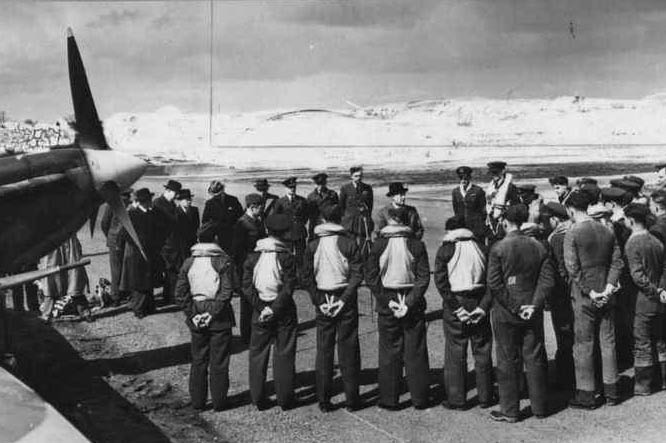
On 9 April 1940 at about 4 am, German forces crossed the Danish border. Two hours later, the German ambassador received the Danish surrender and the Danish High Command gave order to all units to cease fighting. In surrendering practically without resistance, the Government attempted to safeguard as much sovereignty as possible during a German “peaceful occupation". As a consequence, and in contrast to the situation in other countries under German occupation, most Danish institutions continued to function relatively normally until 1943.[1] In London, the surrender divided the Danish community. The Danish ambassador to the United Kingdom, Count Edouard Reventlow, continued to serve the government in Copenhagen in spite of the German occupation. He maintained this position until the fall of 1941, when Denmark signed the Anti-Comintern Pact, a treaty initially between Nazi Germany and the Empire of Japan, which many Danes felt compromised Danish neutrality or what remained of it. In contrast to the ambassador, influential members of the Danish community advocated more active support for Britain. Among these was the former planter Werner Michael Iversen, who had returned from Malacca to London in 1939.[2]
On 30 September 1940, the activist members of the Danish community in London formed the Danish Council. The council collected funds and did propaganda work in the Danish exile community through the newspaper Frit Danmark (A Free Denmark) during the war. From the very beginning, the council maintained a recruiting office for Danish nationals of which Werner Michael Iversen became commanding officer. The office’s primary task was to recruit men for the East Kent Regiment (the Buffs), of which the King Christian X was honorary colonel, and women to the Auxiliary Territorial Service. In addition, the office also facilitated the recruitment of volunteers to the RAF and for WAAF. In total, about 1,000 Danish men and women volunteered for service in the Allied forces during the war.[3] Of these more than 250 volunteered in the air forces, including about 110 served in RAF and WAAF.[4]
The Dream: A Danish Squadron
In the summer of 1941, a delegation of the Danish Freedom Council in London travelled to North and South America to visit Danish communities on that continent. At this point in time, the first Norwegian fighter squadron, 331 Squadron, had been formed. Even earlier Belgian, Dutch, Polish, and Czech pilots were flying in national units under RAF control. French and Greek pilots were soon added to the list. The Free Danes longed to be part of the fight too, but their situation was different than that of the other countries. No formal government in exile existed, and the Danish armed forces had not evacuated to Britain, as was the case for the Norwegians for instance. During the journey, the delegation presented a plan to collect funds to establish a Danish fighter squadron and - if possible - man it with Danish pilots or pilots of Danish origin. In consequence, a number of Danish fighter funds were set up in both North and South America, aiming at collecting £ 65,000 or enough funds for at least 12 Spitfires. In Britain and Northern Ireland, the Danish Council’s fund began operating towards the end of October 1941.[5]
The Danish initiative was by no means unique. In 1940, while the air war was raging in the skies over Southern England, a large number of Spitfire Funds were set up all over the world by corporations, counties, organisations and the like. The aim was to raise money for aircraft production. The tradition of donating money for weapons for the armed forces was not new. For centuries armament had been supplied by private initiative. In these dark hours, as the German forces were planning to cross the Channel, the idea caught on again.[6] During the war, Spitfire Funds all over the world donated more than £20 million.[7]
The Danish collection did not meet the council’s expectations in the end. At the last meeting of the Fighter Fund Committee on 26 March 1942, the donations had reached a total of £35,574. The result of the collection in the United States was disappointing, and the council members felt let down. Following Pearl Harbor, the Danish-Americans had shifted their support to the new rather than the old country. About half of the donations originated from Britain and Northern Ireland. The second largest contribution was from Danes in Argentina donating £ 6,877 followed by communities in South Africa and Canada. At this point, the council had realised that they would not be able to establish a full Danish squadron. They simply could not muster enough trained men for a full squadron. Instead they aimed to establish a Danish flight within an existing squadron. On 9 April 1942, a total of £ 38,000 was donated to the British authorities. Eventually, this sum increased to a total of £ 40,972 or enough money to fund eight Spitfires.[8]
The Donation
At the beginning of March 1942, Mr. Max Jensen, who was a member of the Fighter Fund Committee had approached Lord Leathers, the Minister of War Transport, who was a personal friend, if he would ask Prime Minister Winston Churchill to accept the Danish donation in person. Foreign Office supported the initiative stating that the presence of the Prime Minister
…would give great pleasure and encouragement to the Danes, who have really done very well in collecting this substantial sum. The Danes are making a considerable contribution to the Allied cause. […] In this country the Danes are co-operating actively in the war effort. The most important contribution is that of the 3-4,000 Danish seamen, but there is also a small contingent of Danes in the “Buffs", and some volunteers in the R.A.F., recruiting being encouraged by the Danish Council.(NA: FO 371/32430)
On 9 April 1942, the second anniversary of the German occupation of Denmark, the result of the collection was presented to Prime Minister Winston Churchill at No. 10 Downing Street. The delegation consisted of representatives of the Danish Council in London, including Captain Werner Michael Iversen and Plt Off. Jørgen Thalbitzer. On this occasion, the Prime Minister said,
We shall never pause in our struggle, nor will our great American and Russian allies, and I have very little doubt that the day will come — perhaps sooner than it would be prudent or sensible to hope — when Denmark will be free from the grip in which she has been held, and when she will resume her independent, honoured, and ancient place among the free peoples and States of Europe. […] We never have forgotten those days, nor have we forgotten the longer days in the past when our armies served together. We shall do our utmost to repay your country with good results. Good weather is needed to turn this splendid cheque for £38,000 into the first heavy thunder drops of the storm which has to beat upon this odious tyranny. Churchill, 1946
The event was widely reported not only in the Danish newspaper in London, Frit Danmark, but also in newspapers around the world.[9]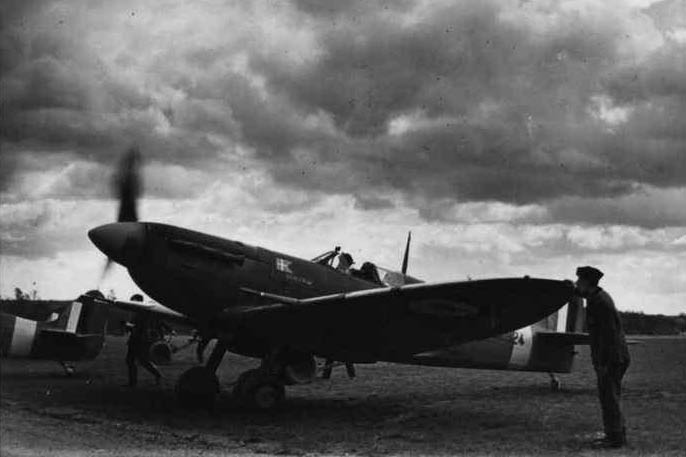
The next day, the first three Spitfires were presented to the Royal Air Force and No. 234 (Madras Presidency) Squadron at a ceremony at RAF Station Ibsley. Present at Ibsley were also notable members of the Danish community.[10] Plt Off. Jørgen Thalbitzer, who had also attended the event the day before, was one of two Danish pilots serving in this unit who demonstrated the aircraft in the air. Thalbitzer had been born on 22 May 1920 in Copenhagen. He had been interested in aviation from early age, and in 1939 he had been the youngest Dane to qualify as pilot at the time. He experienced the German occupation at first hand in April 1940, but on 26 December 1940 he left Denmark under the guise of being tobacco merchant travelled to Istanbul. On the journey, he was accompanied by Sigfred Johannes Christophersen, who was later dropped by parachute over Denmark an SIS-agent, and, having been withdrawn, lost his life while training as pilot in RAF. From Istanbul they travelled via Cyprus, Suez and Cape Town to London. The exact time of arrival in London is not clear, but on 9 April 1941 he spoke in a broadcast to Denmark by the BBC. He served in the Royal Air Force from the beginning of May 1941 and was commissioned on 28 October 1941.[11]
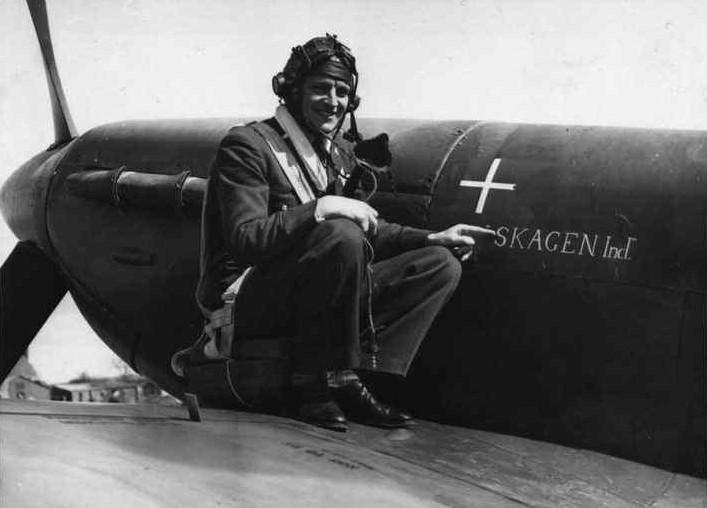
The other pilot was Plt Off. Aksel Svendsen (or Axel, a spelling he also used). Svendsen too had been born in Copenhagen on 21 April 1922, but unlike Thalbitzer he grew up in England. The family had moved to England (Exeter, Devon) in 1928 where his stepfather, Svend Iversen, became director of the Danish Bacon Company. At the outbreak of war, aged 17, he volunteered for RAF, but he did not pass the necessary tests to be admitted. In 1941, he made a second successful attempt. He got his pilot’s wings on 11 July 1941 and commissioned at the same time.
The Spitfires
The three aircraft presented at Ibsley were Spitfire Vb BL831 AZ-K; BL855 AZ-U; and BL924 AZ-G. All three aircraft were taken on charge at No. 4 MU Ternhill on 16 February 1942 and went to No. 234 (Madras Presidency) Squadron on 5 April, where they were used in operations from RAF Ibsley over France, often piloted by one of the Danish pilots of the squadron. The aircraft were baptised "Skagen Ind", "Niels Ebbesen", and "Valdemar Atterdag."
While the identity of the three initial presentation Spitfires seems clear, the precise combination of presentation name, aircraft serial and identification letter is more uncertain. This part of the article re-examines the evidence.

The words "Skagen Ind" had become the motto for the collection of funds among Danes in the British merchant marine. The seamen's dream was yet again to be Inbound (Ind) to Skagen (or the Skaw), the northernmost tip of Denmark, with the Danish flag waving from the stern, returning to a liberated Denmark. This sentiment was encapsulated in the words "Skagen Ind". As early as 9 November 1941, the Danish newspaper Frit Danmark reported that "Skagen Ind" had been chosen as the name of a Spitfire.
In most Danish sources the name "Skagen Ind" is associated with BL831, but in their book Gifts of War: Spitfires and Other Presentation Aircraft in Two World Wars (2005), Boot and Sturtivant list no less than three Spitfires to have been named "Skagen Ind": BL830, BL831, and BL924. There is evidence for this. As for the first two, the Air Ministry Form 78s (aircraft movement cards) clearly indicate this. As for the last, BL924, it is documented in a photo of the aircraft.
Despite the sources, I find it highly unlikely that more than one aircraft actually bore the name, and the photographic evidence strongly suggests that this aircraft was BL924. The only existing photo of a Danish presentation aircraft, in which both name and serial are visible, is the photo of BL924 as "Skagen Ind". The photo is part of a series of photos of the presentation ceremony on 10 April 1942, which also includes a number of photos showing Svendsen on the wing of "Skagen Ind". According to his logbook, held at the Tangmere Military Aviation Museum, it was Svendsen who took BL924 into the air on this day. Hence, there is no doubt that BL924 was presented to the RAF as "Skagen Ind". From 10-24 April 1942, Svendsen logged 25 flights in BL924 and only five in other aircraft, including one in each of BL831 and BL855. Due to the many sorties flown in the aircraft, it is highly unlikely that BL924, indeed any of the three aircraft, was re-named (and re-painted) within their first two weeks in the squadron. By the same logic, therefore, one can dismiss BL831 as having been named "Skagen Ind". Both aircraft were lost on 24 April.
BL830's connection to the name "Skagen Ind" is a mystery. This aircraft was taken on charge at No. 6 MU Brize Norton on 14 February 1942 and allocated to 129 (Mysore) Squadron on 8 March: a month before the Danish donation. The aircraft was never allotted to No. 234 Squadron. Therefore, it could not have been one of the initial three aircraft. Furthermore, a Danish pilot never — I am quite sure — flew the aircraft, which was the whole point of the donation in the first place. I have to acknowledge that the aircraft’s Form 78 clearly states "Skagen Ind", but I believe this to be an error by either the clerk filling in the Form 78 or the man responsible for painting the names on the aircraft according to the form.
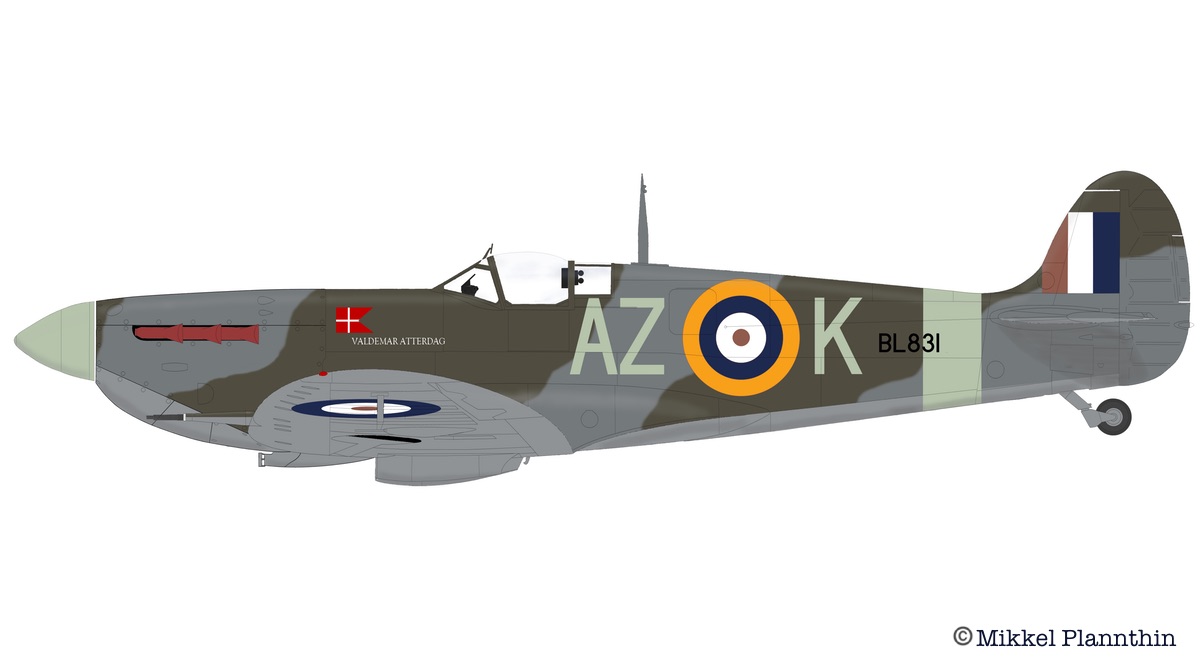
The second Spitfire was called "Valdemar Atterdag" after the King of Denmark from 1340 to 1375. In this context, the name is most commonly associated with BL924 as also noted on the aircraft's Form 78. Since this aircraft was most likely "Skagen Ind", either BL831 or BL855 must have been named "Valdemar Atterdag". The most obvious theory is that BL831 and BL924 somehow got mixed up, and BL831 - not BL924 - was named "Valdemar Atterdag".
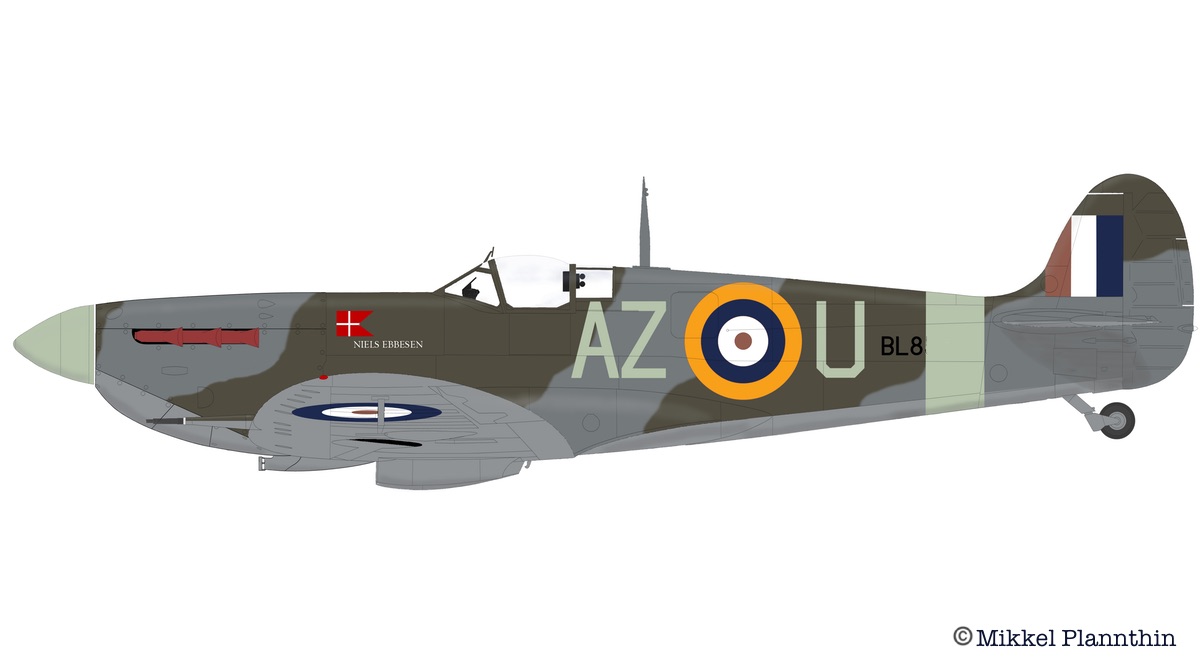
The third aircraft was named "Niels Ebbesen" in honour of the 14th century Danish national hero. In 1340, he killed the German Count Gerhard III of Holstein. The murder eventually led to the end of Denmark's rule by the Counts of Holstein and King Valdemar IV Atterdag taking the Danish throne. All sources associate BL855 with the presentation name "Niels Ebbesen". The RAF Museum does not hold a copy of Air Ministry Form 78 for BL855. Therefore, I have never been able to verify if the form associates BL855 with "Niels Ebbesen". Aksel Svendsen on the wing of Spitfire Vb BL924 AZ-G "Skagen Ind" at RAF Ibsley, 10 April 1942.
My evidence, so far, suggests that the three initial Danish presentation Spitfires were BL831 AZ-K "Valdemar Atterdag"; BL855 AZ-U "Niels Ebbesen"; and BL924 AZ-G "Skagen Ind". If this was the case, then the replica Spitfire BL924 AZ-G that was in Tangmere's Merston Hall, which I visited many years ago, ought to have borne the name "Skagen Ind", not "Valdemar Atterdag".

In 1943, the Council donated additional four Spitfires. According to the minutes of the Working Committee of the Danish Council they were given the names "Denmark 4", "Denmark 5", "Denmark 6", and "Denmark 7".[12] According to Boot and Sturtivant an eighth Spitfire, named "Holger Danske" was donated before the end of the war. Holger Danske (or Ogier the Dane) is a legendary character, who is supposed to have been one of Charlemagne's knights. According to the Danish popular tradition, Holger Danske was said to be asleep in Kronborg Castle (Elsinore in Shakespeare's Hamlet), his beard grown attached to the stone table. Here he would sleep until the day the country found itself in peril, at which time he would rise up and save the nation. Boot and Sturtivant further suggest that a Handley Page Hampden was a presentation aircraft. This is not the case. Hampden AN156 XA-K of No. 489 (RNZAF) Squadron did indeed have a Danish flag and the inscription "King Kristian-D X" painted on the fuselage, but this was the private initiative of the Danish pilot, Flt Lt Henning Pedersen; it was not an official presentation aircraft.[13]
Into Battle
The Danish Spitfires were soon to see battle.[14] BL831 and BL924 were the first to become operational. On 16 April 1942 at 14.45 hours, Sergeant Fisher took off in BL831 with eight other aircraft to act as high cover to six Hurricane bombers. Eight of the aircraft became detached from the main formation and were attacked by German Bfl09 fighters. Pilot Officer Bland was posted missing from this operation. At 20.05 hours, Svendsen took off in BL924 on his first operation with 234 Squadron, a scramble patrol. The next day, all three Danish Spitfires were in the air. Svendsen, Thalbitzer, and eight other pilots participated in a rodeo over the Cherbourg peninsula. Svendsen was flying in BL924, and Thalbitzer in BL831. They were acting as top cover for 118 and 501 Squadrons (the Ibsley Wing), in an offensive operation in the area. Three pilots were engaged in battle with Fwl90s from JG 2 and damaged one German aircraft. Later in the afternoon, Pilot Officer Drinkwater took off in BL855 on an escort to six Bostons attacking Cherbourg harbour. Over the following days Svendsen and Thalbitzer took off together in BL924 and BL831 respectively on several operations, while Drinkwater piloted BL855.
On 24 April 1942, the RAF carried out two circus operations over Northern France. In Circus 133, six Bostons of 88 Squadron were to bomb the airfield at Abbeville. The Ibsley Wing, operating from Tangmere, was acting as escort. Over the French coast at Cap Griz Nez, the wing was intercepted by Fwl90s from II/JG26 from Abbeville/Durat. Four Spitfires were shot down. Svendsen in BL924 and Flight Lieutenant Vivian Eugene Watkins in BL831 were among the pilots posted missing in action. The 234 Squadron Operations Record Book records:
The Squadron operating from Tangmere together with 501 and 118 Squadrons carried out a fighter sweep over the French coast at Berck sur Mer. Seven of our aircraft became separated from the main formation when reaching the French coast and attacked from above and astern by 20 F.W.190s. Black and Red Sections (F/Lt. Watkins (U.S.A.) F/Sergt. Fisher, (CAN) P/O Svendsen, (Danish) and Sgt. Machan (Canadian) are missing from this operation.(NA: AIR 27/1439)
The German pilot who shot down Svendsen was one of three pilots claiming a fighter in the area that day. The first was Staffelkapitan of 4th Staffel, Oberleutnant Kurt Ebersberger, who claimed his 20th and 21st victory. The second was Oberleutnant W. F. Galland, brother of the famous Adolf Galland, claiming his 6th victory. The third was Oberfeldwebel Herman Hoffmann, also claiming his 6th victory. I am not able to further narrow down the German pilot, but it is clear that 234 Squadron was unevenly matched in the air. Not only did the Germans fly more powerful aircraft, Fw 190A-2s, they were also very experienced pilots of Hauptmann Hans Jochen Muncheberg's "Abbeville Boys".
This is the end of Svendsen’s story and also the end of both "Skagen Ind" and "Valdemar Atterdag"; all were lost that day. Svendsen had been at the squadron for three weeks, and flown twelve missions in eight days. He was only 20 years old.
Svendsen's death must have taken its toll on Thalbitzer. They were friends and had been so since flying training. The squadron had been hit hard. On 27 April 1942, it was withdrawn to regroup at RAF Station Portreath in Cornwall. Of the three Danish Spitfires only BL855 was left. Thalbitzer continued flying with the squadron, but seldom in BL855. The aircraft was damaged on 25 April 1942 when Sergeant W. J. Marshall forgot to close the side door of the aircraft while taking off. He crashed and the aircraft was repaired at Westland Aircraft.
On 7 June 1942, a third Dane, Jens Ipsen, arrived at the squadron. Ipsen was born on 7 November 1913 in Sønder Hygum, Denmark. He was educated at Aarhus Business School before the war graduating with honours in 1937. During a visit in Paris he volunteered for the French Foreign Legion, but eventually he came to serve in the RAF, training with Svendsen and Thalbitzer. While in training at RAF Sutton Bridge, he crashed in Hurricane IV7004 breaking a leg. He spent a month in an RAF hospital. It is very likely that he was the third Danish pilot who was meant to demonstrate the aircraft at the presentation of the Danish Spitfires on 10 April 1942. On 15 June 1942, Ipsen and Thalbitzer took off together on a patrol operation, Ipsen's first at the squadron. During the next weeks they were to fly a number of mainly convoy patrol operations together.
This changed on 27 July 1942. Thalbitzer took off on a mass rhubarb over northern France accompanied by eleven other aircraft. They carried out low-level attacks on a number of targets between Plouescat and Guissény in Brittany. They were intercepted by German fighters and also hit by flak and machine-gun fire from Landerneau. Thalbitzer's aircraft was hit and his engine stopped. He managed to make an emergency landing near Plouescat. He was unhurt, but was soon taken prisoner by the Germans. He was one of four pilots shot down on the mission. This was the end of Thalbitzer's time with 234 Squadron.
He was imprisoned in Stalag Luft III (No. 629), where he joined the team of escapers. As a result he ended up in a punishment camp at Schubin, Poland (Oflag XXIB). In March 1943, he was among more than thirty prisoners to escape from the camp. Thalbitzer had teamed up with Lieutenant Commander Jimmy Buckley of the Fleet Air Arm, who had chaired the escape committee at Schubin. Their plan was to reach Stettin on foot and to board a Danish vessel, but on reaching Stettin they ran out of luck, as there were no Danish vessels in port. Instead they jumped on a freight train for Rostock, but had no better luck there. In the end they boarded a vessel in Hensburg. They eventually arrived in Copenhagen where Thalbitzer left Buckley in the ship. By coincidence he met his father in a train station, and briefly had the chance to tell his story. On the night of 28/29 March 1943 Buckley and Thalbitzer attempted to cross the Sound between Denmark and Sweden in a small open boat, but they disappeared possibly being swamped by a wave or run down by a larger vessel. The body of Buckley was never found, but Thalbitzer's body washed ashore some months later. He was identified by his signet ring.[15]
Ipsen continued operations at the squadron only hours after the loss of Thalbitzer. During the following months he carried out 45 operations, mainly convoy patrols. On 6 October 1942 he was joined by yet another Danish pilot, when Flying Officer Michael Randrup was posted to the squadron. Randrup was born on 20 April 1913 in Moscow, where his father owned a plough manufacturing company. Following the Russian revolution, they settled in Britain, where Randrup grew up. From an early age he had been interested in flying, getting an "A" license in July 1936. He attempted to join the RAF before the war, but was rejected as he was not British subject. Instead the attended the College of Aeronautics in Chelsea and established an air charter company with his cousin, later Air Transport Auxiliary pilot Ivan Christian Randrup. Following the German occupation of Denmark, he was accepted for Royal Air Force.
On 26 October 1942, Randrup took off in BL855 on his first operational mission. It was the only time he flew this aircraft. He was not posted at the squadron for very long. On 1 January 1943, he proceeded to Air Service Training Ltd at Hamble as test pilot and in 1944 he was attached to Royal Aircraft Establishment, Farnborough.
Only three days later, on 4 January 1943, Ipsen was posted to No. 1 Personnel Despatch Centre, West Kirby, to be transferred to Malta in June 1943. Ipsen was the last Danish pilot to fly BL855, on 7 November 1943. No Spitfire in RAF service was flown by more Danish pilots than this aircraft. Thalbitzer, Ipsen, and Randrup had used it operationally, while Svendsen had flown her once on a non-operational flight. Eventually, BL855 was converted to a Seafire lb and renumbered NX920, arriving at Lee-on-Solent on 20 May 1943 and allocated to 761 Squadron, Fleet Air Arm.[16]
Thus, at the beginning of 1943 the first four Danish pilots had left 234 Squadron and so had the last of the first three Danish Spitfires. Several Danish pilots would follow during 1943-1944: Jørgen Kjeldbæk, Niels Juul Rysensteen Buchwald, Vagn Christensen, Erik Flohr Jacobsen, and Kjeld C. J. Pedersen — but I have no information about further Danish Spitfires being posted to the squadron. The Danish Council had dreamed of a Danish Spitfire Squadron. No. 234 Squadron was the closest to this they got, even if it never saw more than a single three-aircraft Danish section in the air at the same time.[17] The initiative did not change the course of the war, but it was a boost to the morale in the Danish community, and an important symbol of resistance to Nazi occupation.
This article was first published in the Tangmere Logbook, Magazine of the Tangmere Military Aviation Museum in the Summer 2016 issue.
Notes
[1] Christensen et al., 2006, pp. 89-111
[2] Sørensen, 2011
[3] Ibid.
[4] Plannthin, 2017
[5] Frit Danmark, 23 October 1941
[6] Boot and Sturtivant, 2005.
[7] NA: AVIA 15/2486.
[8] NA: AVIA 15/3725.
[9] Frit Danmark, 16 April 1942.
[10] La Cour, 1946.
[11] Thalbitzer, 1945.
[12] DNA: 10194-0180, 002
[13] According to the Operational Record Book of 489 Sqn, Pedersen flew Hage Pape Hampden 489/K (AN156) during five of eight operations while attached to the squadron.
[14] Operational information primarily based on the Squadron Operational Record Book (NA: AIR 27/1439)
[15] Ash and Foley, 2006
[16] Boot and Sturtivant, 2005
[17] Walpole, 2007